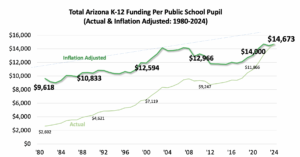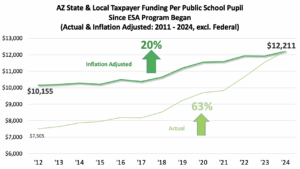Record-Breaking $15K Per-Kid Spending in AZ Public Schools—Amid ESA Growth
Arizona’s public schools are set to break the record for spending this year, nearing a whopping $15,000 per pupil, as they also receive $800 million more in state and local taxpayer funding compared to last year. This funding surge, which comes as demand for Arizona’s universal Empowerment Scholarship Account (ESA) program continues to grow, should be a shock to naysayers who claimed that ESAs would decimate funding for public schools.
Turns out, that couldn’t be farther from the truth. In fact, as the chart below shows, Arizona public education spending has soared over the past four decades:

Source: Annual Reports of the Superintendent of Public Instruction; Joint Legislative Budget Committee All Funding Reports for FY 2001 – 2024. Adjusted for inflation using Bureau of Labor Statistics CPI figures, in constant 2023 dollars.
This week’s news comes from Arizona’s nonpartisan Joint Legislative Budget Committee (JLBC), which just released its new estimates this. The majority of this new funding will go to school districts, rather than charter schools, even though enrollment at districts is projected to decline while enrollment at charter schools is growing.
The total funding for K-12 public education in Arizona is now projected to hit $14,673 per child. That number not only sets a new spending record on Arizona K-12 students, but it also tops the price of college at institutions such as Arizona State University (where resident undergraduate tuition and fees are just $13,161 this year).
Moreover, the reported per pupil K-12 spending number understates the actual taxpayer cost of traditional public schools, since it’s an average of both district and public charter schools, and the latter receive roughly $2,000 less per pupil than their district peers. Looking only at traditional public district schools, therefore, the per child cost of public education will likely exceed $15,000.
In addition, despite the incessant drumbeat of teachers union talking points trying to convince the public otherwise, these new funding levels continue a decades-long trend in spending increases on public education in Arizona. As shown in the chart above, total funding per pupil for Arizona public schools has ballooned to $14,673 from just $2,602 in 1980.
Even when adjusting for inflation, the cost of public education has increased roughly $5,000 (over 50%) per student from $9,618 in 1980 to $14,673 today. That increase translates to an extra $100,000 spent per class of 20 students each year, on average.
These amounts exclude funding for the state’s much lower-cost ESA program, which offers awards of roughly $7,000 per student joining under the universal expansion.
Moreover, for those interested in funding specifically from state and local taxpayers, the second chart below captures the steadily increasing spending on public school students in the years since Goldwater helped create the nation’s first ESA program in Arizona in the 2011-2012 school year. As with the total funding levels, state and local funding for public schools has increased substantially during the years in which the ESA program has operated, rising over $2,000 per student (20%) in inflation-adjusted terms since the program began.

Source: Annual Reports of the Superintendent of Public Instruction; Joint Legislative Budget Committee All Funding Reports for FY 2001 – 2024. Adjusted for inflation using Bureau of Labor Statistics CPI figures, in constant 2023 dollars.
Opponents of school choice often speak of funding cuts to public education, but the upward trajectory over the past several decades obliterates this talking point. And while these same opponents will then often pivot to Arizona’s relative funding compared to other states, they rarely acknowledge the fact that Arizona—like the United States—already spends significantly more per K-12 student than most other developed countries, or that Arizona’s lower cost public charter schools outperform the state’s district schools even when adjusting for student demographics, as researchers at Stanford University recently revealed.
Our goal should not be to maximize the cost of public education, but rather to provide the greatest opportunity for academic enrichment to our students, regardless of the schooling environment chosen to deliver it. Arizona remains a leader in this respect, and families across the state will continue to help steward the (growing) resources available to their children.
Matt Beienburg is the Director of Education Policy at the Goldwater Institute. He also serves as director of the institute’s Van Sittert Center for Constitutional Advocacy.
Get Connected to Goldwater
Sign up for the latest news, event updates, and more.

Donate Now
Help all Americans live freer, happier lives. Join the Goldwater Institute as we defend and strengthen freedom in all 50 states.
Donate NowSince 1988, the Goldwater Institute has been in the liberty business — defending and promoting freedom, and achieving more than 400 victories in all 50 states. Donate today to help support our mission.

We Protect Your Rights
Our attorneys defend individual rights and protect those who cannot protect themselves.
Need Help? Submit a case.






